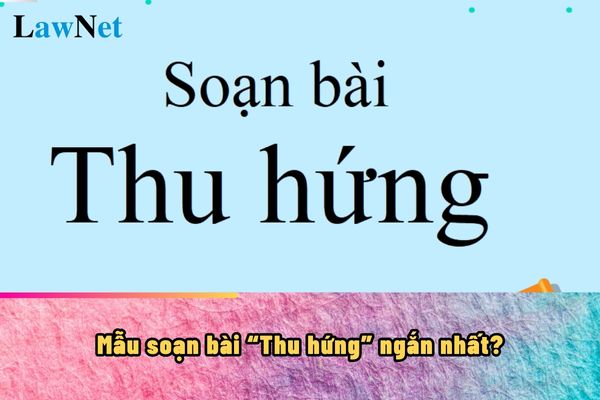What are guidelines on preparing the lesson "Thu hứng" for students in Vietnam? How many periods are there in Grade 10 Literature in Vietnam?
What are guidelines on preparing the lesson "Thu hứng" for students in Vietnam?
"Thu hứng" is among the pieces that students will study in the Grade 10 Literature curriculum.
Students can refer to the following lesson plan for "Thu hứng":
|
The Lesson Plan for "Thu hứng" I. Introduction |
Note: The information about the lesson plan for "Thu hứng" is for reference only./.

What are guidelines on preparing the lesson "Thu hứng" for students in Vietnam? How many periods are there in Grade 10 Literature in Vietnam? (Image from the Internet)
According to the program, how many periods are there in Grade 10 Literature in Vietnam?
Based on the General Education Curriculum for Literature, issued with Circular 32/2018/TT-BGDDT, the duration for implementing the program is specified as follows:
- Program duration in each grade (according to class periods)
| Grade 1 | Grade 2 | Grade 3 | Grade 4 | Grade 5 | Grade 6 | Grade 7 | Grade 8 | Grade 9 | Grade 10 | Grade 11 | Grade 12 |
| 420 | 350 | 245 | 245 | 245 | 140 | 140 | 140 | 140 | 105 | 105 | 105 |
In upper secondary school, each grade has an additional 35 periods for elective study modules.
- Duration allocated for educational content
Duration for educational content is arranged proactively by textbook authors and teachers based on the requirements for each grade and teaching reality. However, a reasonable balance must be ensured among the following components:
+ Between imparting knowledge and skills training (with emphasis on practical skills and application).
+ Among different types of texts for reading, writing, speaking, and listening (more time allocated for reading literary texts).
+ Among reading, writing, speaking, and listening skills (more time allocated for reading skills); specifically, the proportion of time allocated for each skill in each grade is as follows:
| Grade Group | Reading | Writing | Speaking and Listening | Periodic Evaluation |
| From Grade 1 to Grade 3 | about 60% | about 25% | about 10% | about 5% |
| From Grade 4 to Grade 5 | about 63% | about 22% | about 10% | about 5% |
| From Grade 6 to Grade 9 | about 63% | about 22% | about 10% | about 5% |
| From Grade 10 to Grade 12 | about 60% | about 25% | about 10% | about 5% |
Thus, according to the regulations, Grade 10 Literature has 105 periods, wherein approximately 60% is for reading, about 25% for writing, speaking and listening account for about 10% of the time, and the remaining 5% is used for periodic evaluation.
There are also an additional 35 periods for elective study modules.
What are regulations on assessment for Grade 10 Literature in Vietnam?
Based on Clause 3 Article 5 Circular 22/2021/TT-BGDDT on the forms of assessment:
Form of assessment
...
- Assessment form for subjects
a) Qualitative assessment for subjects: Physical Education, Arts, Music, Fine Arts, Locality-based Education Content, Experiential Activities, and Career Guidance; academic results for subjects are qualitatively assessed in one of two levels: Achieved, Not achieved.
b) Combined qualitative assessment with scoring for subjects in the General Education Program, except for subjects specified in point a of this clause; academic results for subjects are scored on a scale of 10, and if another scale is used, it must be converted to a scale of 10. The score can be an integer or decimal rounded to the nearest tenth.
Thus, Grade 10 Literature is assessed using a combined approach of qualitative evaluation and scoring. Academic results for the subject are scored on a 10-point scale.

